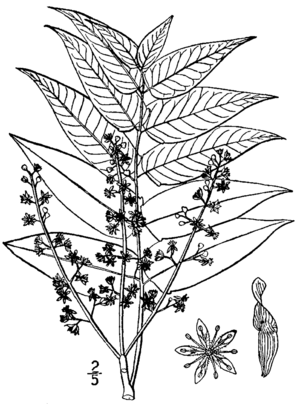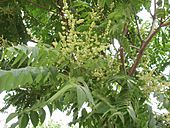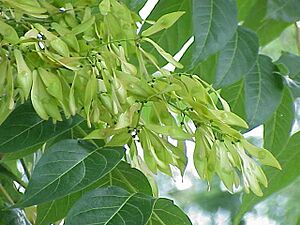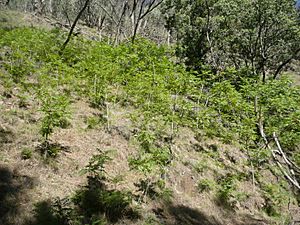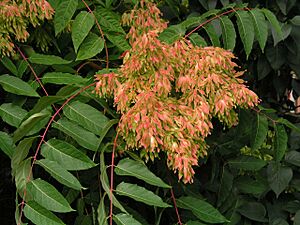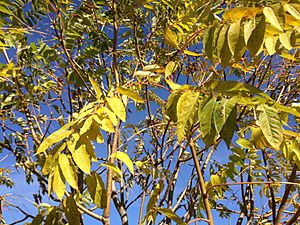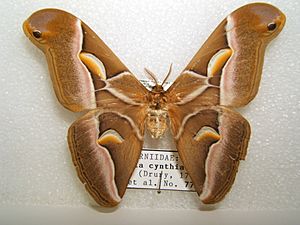Tree of heaven facts for kids
Quick facts for kids Tree of heaven |
|
|---|---|
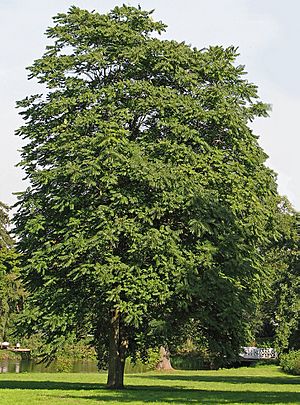 |
|
| Large specimen growing in a park in Germany | |
| Scientific classification | |
| Genus: |
Ailanthus
|
| Species: |
altissima
|
| Synonyms | |
|
|
The Ailanthus altissima, also known as the tree of heaven, is a fast-growing tree. It is a deciduous tree, meaning it loses its leaves every autumn. This tree is originally from China and Taiwan. Unlike many trees in its family, it grows in cooler, temperate places, not just warm, tropical ones.
This tree grows very quickly. It can reach heights of 15 meters (50 feet) in just 25 years! Most trees of heaven live for about 50 years, but some can live for over 100 years. It can also make copies of itself from its roots. Because it grows so fast and spreads easily, it is considered a noxious weed and an invasive species in many parts of the world, especially in Europe and North America. It is one of the worst invasive plants around.
Contents
What Does the Tree of Heaven Look Like?
The tree of heaven is a medium-sized tree. It usually grows to be about 17 to 27 meters (55 to 90 feet) tall. Its trunk can be about 1 meter (40 inches) wide. The bark is smooth and light gray when young. As the tree gets older, the bark becomes a bit rougher with light tan cracks.
The twigs are strong and can be reddish or chestnut colored. They have heart-shaped scars where leaves used to be. All parts of the tree have a strong smell. Some people say it smells like peanuts or rotting cashews.
Leaves and Flowers
The leaves are very large, from 30 to 90 cm (1 to 3 feet) long. They have many smaller leaflets, usually 10 to 41 of them. When new leaves appear in spring, they are bronze. Then they turn green as they grow. Each leaflet is about 5 to 18 cm (2 to 7 inches) long. A special feature of these leaflets is that they have two to four teeth near their base. Each tooth has a small gland at its tip. This helps tell them apart from similar trees like sumac.
The flowers are small and grow in large clusters. These clusters can be up to 50 cm (20 inches) long. The flowers are yellowish-green to reddish. They have five petals and five sepals. Flowers appear from mid-April to July, depending on the location.
The tree of heaven has separate male and female trees. Male trees produce more flowers than female trees. Male flowers also have a bad smell to attract insects for pollination. Female flowers develop into fruits.
Seeds and Reproduction
The fruits grow in large clusters, with hundreds of seeds in each cluster. The seeds are small, about 5 mm (0.2 inches) wide. Each seed is inside a twisted, wing-like case called a samara. These samaras are about 2.5 cm (1 inch) long. They spin like helicopter blades when they fall, helping the wind carry them far away. They can also float on water, spreading even further.
Female trees can produce a huge number of seeds. A single tree can produce around 30,000 seeds per kilogram (14,000 per pound) of tree! These seeds can stay on the tree until the next spring.
History of the Tree of Heaven
The tree of heaven has a long history in China. It was mentioned in ancient Chinese books and used in traditional Chinese medicine. People used its roots, leaves, and bark as a medicine.
This tree was also grown to feed ailanthus silkmoths. These moths produce a type of silk that is strong and cheaper than regular silk. The tree of heaven even became famous in Western culture. It was the main subject of the popular book A Tree Grows in Brooklyn.
Coming to Other Countries
The tree was first brought from China to Europe in the 1740s. Then, in 1784, it arrived in the United States. At first, people thought it was a beautiful garden plant. However, they soon realized it spread very quickly and had a bad smell. Despite this, it was widely used as a street tree in the 1800s.
Today, the tree of heaven is found in many places outside its native home. It is considered a noxious weed in many countries. It is an invasive species because it can quickly take over disturbed areas. It also releases chemicals that stop other plants from growing. When you cut the tree down, it grows back very strongly from its roots. This makes it very hard to get rid of. Because of this, gardeners sometimes call it the "tree of hell."
Where Does the Tree of Heaven Grow?
A. altissima is naturally found in northern and central China, Taiwan, and northern Korea. It has also been found as fossils in North America, showing it was there a long time ago.
This tree likes moist soil, but it can grow in many different types of soil. It can handle dry conditions but not floods. It also needs a lot of sunlight. In China, it often grows in areas with lots of limestone. The tree of heaven can grow in many different climates, from high mountains in Taiwan to lower areas in mainland China.
Spreading Around the World
The tree of heaven first spread to southern Korea and Japan. It was then brought to the United States in 1784. In both Europe and America, it quickly became a popular tree for gardens and streets. By 1840, most plant nurseries sold it. Chinese immigrants also brought it to California in the 1890s during the Gold Rush.
Now, it has escaped from gardens and grown wild in many places. It is found across much of Europe, including Germany, Austria, and countries around the Mediterranean Sea. It has also spread to Argentina, Australia, New Zealand, the Middle East, and parts of South Asia. In South Africa, it is listed as an invasive plant that needs to be controlled.
In North America, the tree of heaven grows from Massachusetts to California and from Florida to Washington. In cities, it often grows in disturbed areas like along roads and railways. It can also invade natural areas and compete with native plants. Because it produces so many seeds and can regrow from its roots, it often outcompetes native species. This is why many states classify it as a harmful or invasive plant.
How the Tree of Heaven Affects Nature
The tree of heaven is an opportunistic plant. This means it takes advantage of places with full sunlight and disturbed ground. It spreads aggressively using both its seeds and its roots. If you cut it down, it quickly grows back from the roots. It doesn't like deep shade, so it usually can't compete in very dark forests. However, it can grow very fast in gaps in the forest canopy where sunlight breaks through.
This tree is very good at handling pollution. It can absorb harmful gases like sulfur dioxide in its leaves. It can also survive near cement dust and coal tar fumes. High levels of mercury have even been found in its tissues.
The tree of heaven has been used to regrow plants in areas damaged by acid mine drainage. It can tolerate very low pH levels, like that of tomato juice. It can also grow in soils with low phosphorus and high salt. Its roots are strong and can even damage underground pipes. Along highways, it often forms thick groups where few other trees can grow. This is partly because it produces toxins to stop other plants from competing. The roots are also poisonous to people.
Ailanthone: A Natural Chemical
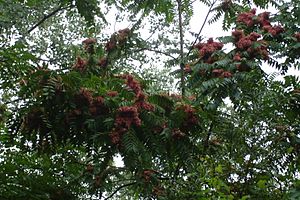
The tree of heaven makes a special chemical called ailanthone. This chemical stops other plants from growing. The strongest parts of the tree for this chemical are the bark and roots. But it is also found in the leaves, wood, and seeds.
One study showed that a liquid from the root bark stopped 50% of garden cress seeds from sprouting. The same study found that this liquid could kill almost all seedlings of other plants, like redroot pigweed. It was very harmful to many North American hardwood and conifer trees. Only white ash trees were not affected. However, ailanthone does not harm the tree of heaven's own seedlings. This means the tree has a way to protect itself from its own poison. Plants that have been exposed to ailanthone before become more resistant to it.
The tree of heaven is one of the fastest-growing trees. It can grow 1 to 2 meters (3.5 to 6.5 feet) per year for its first four years. Shade slows its growth a lot. Even older trees grow faster than many other trees.
In northern Europe, the tree of heaven became common in cities after World War II. This was because it could grow in the rubble of destroyed buildings where other plants could not. Cities also have warmer temperatures, which helps the tree grow. For example, in Berlin, the tree of heaven was found in 92% of crowded city areas.
Insects and Diseases
Several types of moths eat the leaves of the tree of heaven. In North America, the ailanthus webworm uses it as a host plant. This moth is originally from Central and South America. In the US, the tree also hosts the brown marmorated stink bug and the spotted lanternfly. In its native China, the tree of heaven is home to at least 32 types of insects and 13 types of fungi.
A tiny mite called Aculops ailanthii sometimes attacks the leaves in North America. When mites infest the leaves, they curl up and become shiny, which hurts the tree's ability to grow. Scientists are studying if this mite could be used to control the tree of heaven in America.
Because the tree of heaven spreads so easily, people try different ways to control it. For example, the city of Basel in Switzerland has a program to get rid of it. It can be very hard to remove. People use physical methods (like cutting), heat, special management, biological controls (like the mite), or chemicals (herbicides). Often, a mix of chemical and physical methods works best. Recent research shows that a fungus called Verticillium nonalfalfae might also help control A. altissima.
Uses of the Tree of Heaven
Besides being an ornamental plant, the tree of heaven is used for its wood. It is also a host plant for the ailanthus silkmoth (Samia cynthia). This moth produces a type of silk called "pongee" or "Shantung silk." This silk is stronger and cheaper than silk from mulberry trees, but it is not as shiny and doesn't take dye as well.
The wood of the tree of heaven is pale yellow, fine-grained, and satiny. It has been used to make cabinets. It is also flexible and good for making kitchen steamers, which are used in Chinese cooking for things like mantou and rice. The wood is also a good source of firewood because it is moderately hard and heavy. It is also used to make charcoal for cooking.
There can be problems using the wood for lumber. Because the tree grows so fast when it's young, the wood can twist or crack when it dries. However, special drying methods have been developed to prevent this. Once properly dried, the wood becomes quite hard.
Growing the Tree of Heaven
The tree of heaven is a popular ornamental tree in China. People like it because it can grow well even in tough conditions. It used to be very popular in Europe and North America too. But its popularity dropped because of the bad smell of its flowers and how easily it spreads. The male trees produce the smell, so people tried to sell only female trees. However, female trees produce more seeds, which made the spreading problem worse.
In Europe, the tree is still used in gardens to some extent. It is common in London parks and streets. But it is less common in northern England and Scotland. In Germany, it is often planted in gardens. In the west, the tree has also become less popular because it doesn't live very long. Its trunk can become hollow, making older trees unstable in strong winds.
There are a few special types of tree of heaven called cultivars, but they are not often sold outside of China:
- ‘Hongye’ – This Chinese name means "red leaves." It has beautiful bright red leaves.
- ‘Metro’ – This is a male tree with a more compact shape and spreads less.
- ‘Erythrocarpa’ – This type has striking red fruits.
- ‘Pendulifolia’ – This type has much longer leaves that hang down gracefully.
Traditional Medicine Uses
Almost every part of the tree of heaven has been used in Chinese traditional medicine. People believed it had healing powers. However, there is no strong scientific proof that it can cure any diseases.
See also
 In Spanish: Arbol Del Cielo para niños
In Spanish: Arbol Del Cielo para niños


